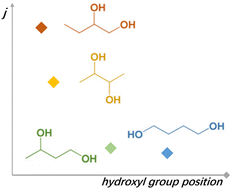The effect of the hydroxyl group position on the electrochemical reactivity and product selectivity of butanediol electro-oxidation†
Abstract
This article presents a study on the effect of the hydroxyl group position on the electro-oxidation of butanediols, including 1,2-butanediol, 2,3-butanediol, 1,3-butanediol, and 1,4-butanediol. The effect of the hydroxyl group position in butanediols on their electro-oxidation reactivities is investigated by cyclic voltammetry, linear sweep voltammetry, chronopotentiometry and chronoamperometry in 1.0 M KOH. The results show that the closer the two hydroxyl groups are, the higher the reactivity, and the lower the anodic potential butanediol has. Moreover, the oxidation products from chronoamperometry are analyzed by means of HPLC and NMR. Some value-added products, such as 3-hydroxypropionic acid/3-hydroxypropionate, are produced. The DFT calculation indicates that the oxidation of vicinal diols responds to the conversion from a hydroxyl group to a carboxylate group, followed by C–C bond cleavage, where the carbon charge decreases. These results provide an insight into reactant selection for the electrochemical synthesis of value-added chemicals.



 Please wait while we load your content...
Please wait while we load your content...